
|
You entered: Saturn
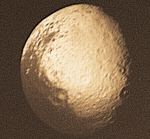 Iapetus: Saturn's Disappearing Moon
Iapetus: Saturn's Disappearing Moon
15.10.1995
Iapetus has an unusual surface, one half of which is very dark, the other half very light. This caused it's discoverer Cassini to remark that Iapetus could only be seen when on one side of Saturn but not the other. The reason for the difference between hemispheres is presently unknown.
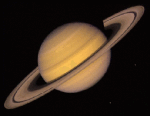 Saturn, Rings, and Two Moons
Saturn, Rings, and Two Moons
6.07.1995
This image of Saturn was made by NASA's robot spacecraft Voyager 2 as it began to explore the Saturn system in 1981. Saturn's famous rings are visible along with two of its moons, Rhea and Dione which appear as faint dots in the right and lower right part of the picture.
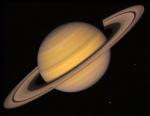 Saturn, Rings, and Two Moons
Saturn, Rings, and Two Moons
18.01.1998
NASA's robot spacecraft Voyager 2 made this image of Saturn as it began to explore the Saturn system in 1981. Saturn's famous rings are visible along with two of its moons, Rhea and Dione which appear as faint dots on the right and lower right part of the picture.
 Looking Down on Saturn
Looking Down on Saturn
21.09.1997
This picture of Saturn could not have been taken from Earth. No Earth based picture could possibly view the night side of Saturn and the corresponding shadow cast across Saturn's rings. Since Earth is much closer to the Sun than Saturn, only the day side of the planet is visible from the Earth.
 A Portrait of Saturn from Titan
A Portrait of Saturn from Titan
16.07.1996
The above artistic portrait of Saturn depicts how it might look from Titan, Saturn's largest moon. In the foreground sits ESA's Huygens probe, which will be released by NASA's Cassini spacecraft. The Cassini mission to Saturn in currently planned for launch in late 1997.
 Looking Down on Saturn
Looking Down on Saturn
17.07.1996
This picture of Saturn could not have been taken from Earth. No Earth based picture could possibly view the night side of Saturn and the corresponding shadow cast across Saturn's rings. Since Earth is much closer to the Sun than Saturn, only the day side of the planet is visible from the Earth.
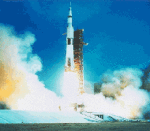 Saturn V: NASA's Largest Rocket
Saturn V: NASA's Largest Rocket
29.08.1995
Pictured, a NASA Saturn V rocket blasts off on July 16th, 1969 carrying the crew of Apollo 11 to the Moon. The Saturn V rocket was the largest rocket ever used by NASA, and the only one able to lift the large masses needed to land astronauts on the moon and returning them safely.
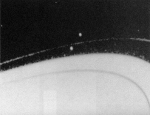 Prometheus, Pandora and Saturn's F Ring
Prometheus, Pandora and Saturn's F Ring
23.12.1995
The third and fourth innermost moons of Saturn were unexpectedly discovered to be gravitational "shepards." The inner moon Prometheus and the outer moon Pandora use their gravitational attraction to define Saturn's outermost ring.
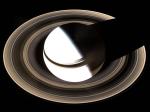 Saturn from Above
Saturn from Above
6.03.2007
This image of Saturn could not have been taken from Earth. No Earth based picture could possibly view the night side of Saturn and the corresponding shadow cast across Saturn's rings. Since Earth is much closer to the Sun than Saturn, only the day side of the planet is visible from the Earth.
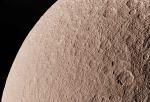 Rhea: Saturns Second Largest Moon
Rhea: Saturns Second Largest Moon
5.12.1999
Rhea is the second largest moon of Saturn, behind Titan, and the largest without an atmosphere. It is composed mostly of water ice, but has a small rocky core. Rhea's rotation and orbit are locked together (just like Earth's Moon) so that one side always faces Saturn.
|
January February March April |
|||||||||||||||||||||||||||||||||||||||||||||||||